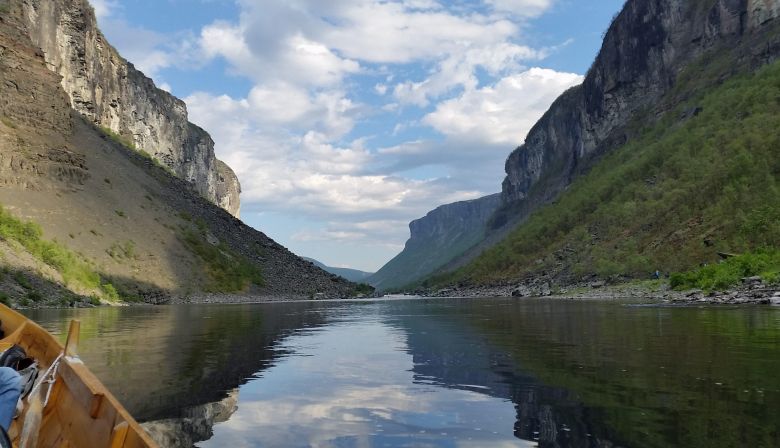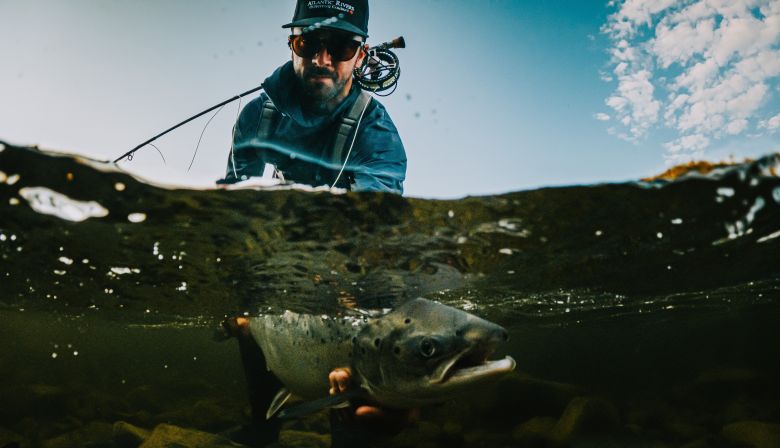
Subscribe & stay up-to-date with ASF

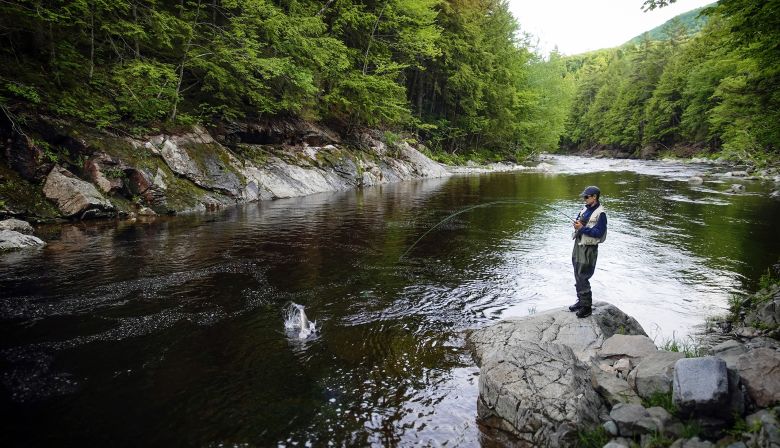
Here on the St. Mary’s River water levels are low, but the riparian floodplain is lush and alive with wildlife and the antics of awkward fledglings. On our walks we’ve come upon beautiful robin’s eggs, a remarkable shade of cyan, tucked safely in their well-appointed nest. We have admired the intricate patterned backs of wood turtles while helping them to safely cross the road. And, to our delight, spotted a juvenille loon feasting at sunset.
Even while not fishing, there is much to see along the river.
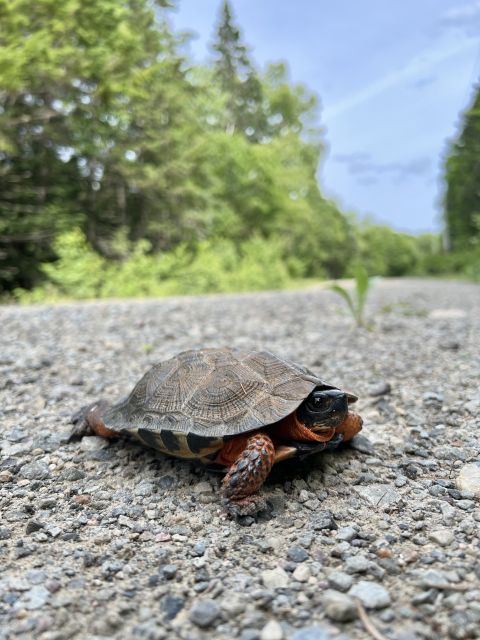
River levels have been holding very well thus far on the lower section of the river in the Blackville area. The same applies for tributaries like the Cains, Dungarvon and Renous. We continue to hear of quite a few anglers hooking into salmon and grilse. Heavy rain last night and into today will improve conditions even more. We are getting hotter temperatures during the day now so this rain is welcome. Reports from anglers coming into the tackle shop are of lots of salmon showing which is very encouraging to hear.
With temperatures on the rise we need to be aware of employing proper hook and release methods. Keeping the fish in the water and reviving them is very important. This rain is exactly what we need. Expect good fishing to continue for the next while.
Visit Brock’s website at Curtis Miramichi River Outfitting.
Many big salmon have been lost once again this week, with one of our guests hooking into a giant fish after playing it for awhile, as it put up an epic battle. The guest was not able to bring it to the net and had to chase it hundreds of meters downriver. Country Haven guide Jeremy Vickers was at his side until the fish finally decided it had enough and was gone. Jeremy has lived on the Southwest Miramichi River his entire life, guiding for most of it, and he said that this fish was one of the biggest salmon he has ever witnessed. It sure would have been nice to see how big the beast really was but as we all know – the big ones always get away!
The full report can be found on Country Haven’s website.
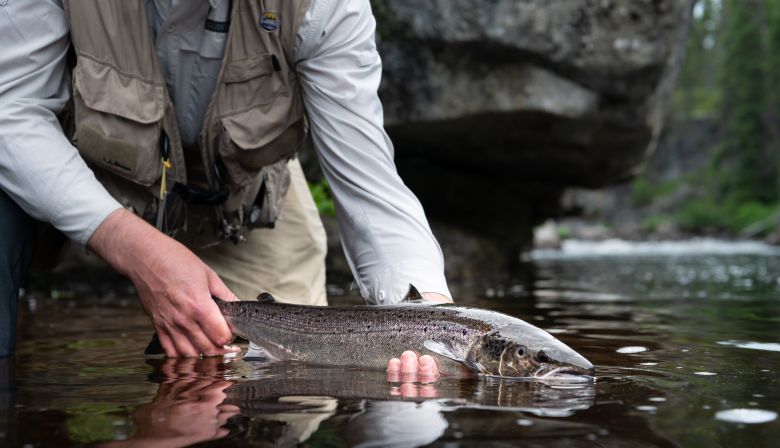
On July 14th the Government of New Brunswick announced the first 84 Nature Legacy protected areas! GNB has committed to doubling its permanently protected land and freshwater from 4.6 per cent to 10 per cent, an area equivalent in size to 19 Fundy National Parks. The first 84 areas will protect about 90,000 hectares and more than 10,000 hectares will soon be added for a total of more than 100,000.
Executive Director of Regional Programs, Nathan Wilbur shares:
ASF and many other Atlantic salmon conservation organizations participated in the nominating process, working with the province of New Brunswick on prioritizing key protections to create resiliency in wild Atlantic salmon watersheds. Protecting forests is the best way to ensure clean, cold water for salmon in the face of climate change. We are pleased to report that among the 84 sites being permanently protected (totalling just over 90,400 ha) a number of high-profile Atlantic salmon rivers have increased protection by capturing their tributaries, floodplains, and/or surrounding forests. Noteworthy examples are:
Restigouche Watershed
Total Area: 15,350 hectares
Tentative name: Wilderness Corridors of the Restigouche
See Quick Facts & Map
Nepisiguit Watershed
Total Area: 7,315 hectares
Tentative name: Nepisiguit Corridor
See Quick Facts & Map
Miramichi Watershed
Total Area: 2,135 hectares
Tentative name: Parks Brook
Notes: Protects more than 9km of the Little Southwest Miramichi River
– Rich Old Forest Wildlife Habitats throughout
Total Area: 3,750 hectares
Tentative name: North Pole Stream
Notes: Headwaters of the Little Southwest Miramichi River
– Nominated by Atlantic Salmon Federation
– Important cold water sources.
See Quick Facts & Map
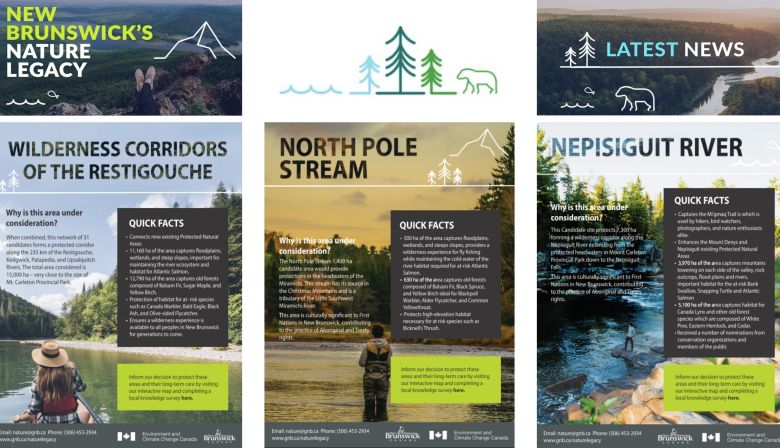

Échos des rivières – Charles Cusson, Directeur québécois:
Les montaisons encourageantes ont continué la semaine dernière, les données en provenance des rivières comme la Madeleine, Mitis et Matane sont très encourageantes à ce jour, le succès de pêche a diminué quelque peu dû aux débits qui sont à la baisse. Si les conditions le permettent, les décomptes de mi-saisons auront lieu la semaine prochaine dont les résultats détermineront s’il y a aura une récolte de grand saumon pendant la deuxième moitié de la saison 2022 peut avoir lieu.
Rappel aux saumoniers pêchant les rivières du Québec, prenez le temps de rapporter vos prises et remise à l’eau afin d’avoir des statistiques précises et que les gestionnaires de rivière puissent calculer le succès de pêche avec précision.
** Les données utilisées dans ce rapport proviennent de divers sites Web, médias sociaux et des sources du gouvernement du Québec.
Rivières York, Dartmouth, Saint-Jean
Communiqué de la Zec Gaspé – Décompte de début juillet
Un décompte de saumon a été effectué sur la rivière York vendredi dernier. Les chiffres sont très encourageants, nous avons un sommet inégalé pour un début juillet, avec 1239 grands saumons ! Nous avons aussi compté 218 madeleineaux et 166 truites de mer. Nous en profitons pour vous rappeler que les truites de mer doivent obligatoirement être remises l’eau, leur capture étant interdite.
Malgré cette montaison exceptionnelle, qui fait suite à deux très bonnes années, il y a un bémol. Nous avons observé une présence plus importante qu’à l’accoutumée de saumons infectés par une maladie fongique, la saprolégniose. Ce champignon qui attaque la peau des poissons et peut causer leur mort est naturellement présent dans tous les cours d’eau de la Gaspésie et ne présente aucun danger pour l’humain. La proportion de saumons qui est infectée varie toutefois grandement d’une rivière à l’autre. La rivière York est celle où les saumons y sont les plus sensibles parmi les rivières de Gaspé. La prévalence de la maladie cette année nous pousse donc à jouer de prudence.
En accord avec le ministère des Forêts, de la Faune et des Parcs, la décision a donc été prise de repousser au 1 août l’ouverture de la capture des grands saumons, initialement prévue pour le 15 juillet, suite au décompte qui aura lieu à la fin juillet. Nous aurons alors un suivi de l’évolution de la situation, à savoir si la maladie s’est résorbée ou s’est aggravée au sein de la population de saumons.
Sachez que nous prenons la situation au sérieux et, en collaboration avec le MFFP, cherchons à identifier les causes de cette plus grande prévalence. Même s’il est fort probable que la majorité des saumons infectés finisse par guérir, comme par les années passées, nous ne connaissons pas les impacts que peut avoir une telle maladie sur la survie à long terme et le potentiel reproducteur des poissons à l’automne.
En terminant, puisque les saumons atteints ne sont pas actifs et ne sont pas capturés, la pêche n’influencera pas leur guérison éventuelle. Vous pouvez donc continuer à pêcher, en remettant à l’eau vos poissons selon les meilleures pratiques, sans avoir d’impact sur la situation.
https://www.facebook.com/SaumonQuebec/videos/1101131217428219
Voici les résultats affichés au 12 juillet sur le site de la Zec Gaspé jusqu’à ce jour en 2022.
York
390 captures (incluant les remises à l’eau) 3 008 jours pêche
Dartmouth
167 captures (incluant les remises à l’eau) 937 jours pêche
Saint-Jean
113 captures (incluant es remises à l’eau) 346 jours pêche
Visiter le https://saumongaspe.com/riviere-york/declaration-de-remise-a-leau.html afin d’enregistrer une remise à l’eau.
Rivière Causapscal
La saison de pêche sportive 2022 sur la Causapscal s’est terminée le 15 juillet avec des résultats impressionnants. 208 prises ont été déclarées, dont 135 remises à l’eau. Un record de tous les temps.
78 prises ont déclaré en 2021, dont 28 qui ont été relâchés afin de poursuivre leur migration vers la période de la fraie.
Pendant la saison 2020, 140 prises, dont 55 remis à l’eau, furent déclarées par les pêcheurs sportifs.
En fin de saison au 15 juillet 2019, 181 prises fut enregistré dont 70 saumons remis à l’eau.
Les chiffres de fin de saison en 2018 démontraient que 166 prises furent déclarées, dont 63 saumons relâchés.
Rivière Matapédia
Jusqu’au 17 juillet 2022, les statistiques publiées par la CGRMP indiquent que 382 prises furent déclarées par les pêcheurs sportifs. De ce total, 279 saumons ont été remis à l’eau et 103 madeleineaux récoltés.
Cumulativement au 20 juillet 2021, la capture de 347 poissons (225 remises à l’eau et 122 madeleineaux récoltés) a été enregistrée avec la CGRMP.
En 2020, à pareille date, 579 captures étaient inscrites comprenant 451 remises à l’eau et la récolte de 128 madeleineaux.
En 2019, cumulativement au 21 juillet, 608 prises furent déclarées (415 poissons relâchés et 193 madeleineaux récoltés).
Rivière Matane
Au 17 juillet, cumulativement, 1 595 poissons (953 saumons et 642 madeleineaux) ont franchi la passe migratoire. 177 prises ont été déclarées, dont 96 saumons et 22 madeleineaux graciés en plus de 59 madeleineaux récoltés.
1 154 poissons avaient franchi la passe migratoire (681 saumons et 873 madeleineaux) en date du 19 juillet depuis le 15 juin 2021. Pour leur part, les pêcheurs sportifs avaient capturé 290 poissons, dont 154 remises à l’eau et la récolte de 136 madeleineaux.
Au 19 juillet 2020, 1 469 poissons (1 050 saumons et 419 madeleineaux) furent dénombrés par le biais de la passe migratoire.
Rivière Mitis
En date du 18 juillet, 973 saumons et 346 madeleineaux ont été dénombrés au piège de capture pour un total de 1 319.
168 remises ont l’eau eu été effectuées sur la Mitis et 23 sur la Mistigougèche. La récolte de madeleineaux se chiffre à 44.
Jusqu’au 20 juillet 2021, 1 592 poissons (738 saumons et 854 madeleineaux) avaient franchi le piège de capture. Pour la rivière Mitis et Mistigougèche, 298 poissons ont été capturés dont 149 remises à l’eau et 145 madeleineaux furent récoltés.
Au 20 juillet 2020, les gestionnaires de la Mitis étaient plus que satisfaits des résultats de montaison et la performance du nouveau piège de capture. À cette date, 1 117 poissons furent transportés en aval du site de capture, dont 613 grands saumons et 504 madeleineaux.
Rivière Madeleine
735 saumons et 386 madeleineaux ont cumulativement franchi la passe migratoire au 17 juillet pour un total de 1 121.
Le 18 juillet 2021, le décompte indiquait que 939 poissons (481 saumons et 458 madeleineaux) avaient franchi la passe migratoire.
Cumulativement au 20 juillet 2020, 1 000 poissons avaient migré par le biais de la passe migratoire, dont (584 grands saumons et 416 madeleineaux).
À pareille date en 2019, cumulativement, 383 poissons furent dénombrés, dont 277 grands saumons et 106 madeleineaux.
Rivière aux Rochers
Les statistiques en date du 17 juillet indiquent que 460 poissons, dont 392 saumons et 68 madeleineaux ont franchi le piège de capture. A pareille date, les pêcheurs sportifs avaient déclaré la capture de 257 poissons, dont 217 saumons et 16 madeleineaux relâchés, 24 madeleineaux récoltés.
Cumulativement au 19 juillet 2021, 386 poissons avaient été dénombrés (169 saumons et 217 madeleineaux). 165 captures déclarées dont 83 saumons et 32 madeleineaux ont été relâchés en plus de 50 madeleineaux récoltés.

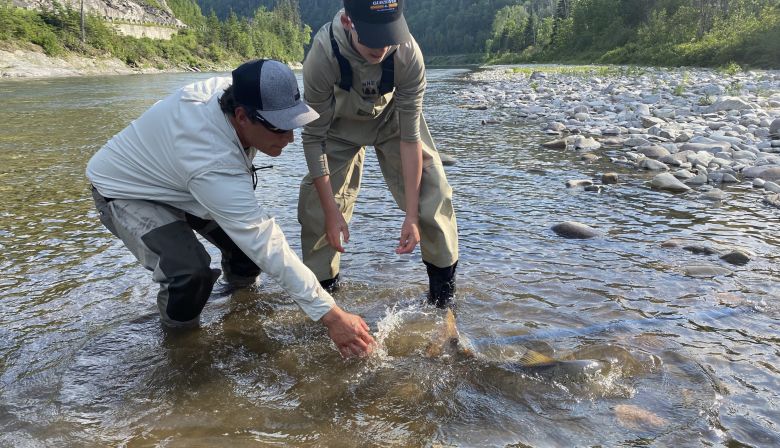
Angling results have slowed down in the last week due to most rivers still dealing with low water levels and higher temperatures. Migration numbers continue to be very encouraging on rivers such as the Matane, Madeleine, and the Mitis. Mid-season assessments will take place next week (conditions permitting) to determine if a harvest of large salmon can take place during the second half of the 2022 season.
Reminder to anglers fishing Quebec Rivers, take the time to report your releases to ensure the most accurate angling statistics so that the river managers may accurately calculate angling success.
Tight Lines!
** Data found within this report has been sourced from various river websites, social media, and Quebec government sources.
York, Dartmouth, Saint-Jean Rivers
An in-river assessment was made on the York River on July 12th. The figures are very encouraging, we have an unequaled peak for early July, with 1,239 large salmon! We also counted 218 grilse and 166 sea trout. We take this opportunity to remind you that sea trout must be released, their capture being prohibited.
Despite this exceptional run, which follows two very good years, there is a downside. We observed a higher than usual presence of salmon infected with a fungal disease, saprolegniosis. This fungus, which attacks the skin of fish and can cause their death, is naturally present in all waterways in the Gaspé and presents no danger to humans. However, the proportion of salmon that are infected varies greatly from one river to another. The York River is one where salmon are most sensitive to it among the Gaspé rivers. The prevalence of the disease this year therefore prompts us to play it safe.
In agreement with the (MFFP) Ministry of Forests, wildlife and parks, the decision was therefore taken to postpone, until August 1, the opening of the capture of large salmon, initially scheduled for July 15, following the count which will take place in the end of July. We will then have a follow-up of the evolution of the situation, to know if the disease has resolved or worsened within the salmon population.
To watch a brief video on saprolegniosis Click Here.
Please be aware we take the situation seriously and, in collaboration with the MFFP, seek to identify the causes of this greater prevalence. Although it is very likely that the majority of infected salmon will eventually recover, as in past years, we do not know the impacts that such a disease may have on the long-term survival and reproductive potential of fish in the fall.
In closing, since affected salmon are not active and are not caught, fishing will not influence their eventual recovery. You can therefore continue to fish, releasing your fish according to best practices, without having any impact on the situation.
For the 2022 season up to July 17th, the Gaspé Zec is reporting the following results:
York
390 captures (includes releases) 3,008 rod days
Dartmouth
167 captures (includes releases) 937 rod days
Saint-Jean
113 captures (includes releases) 346 rod days
To register the release of a fish please visit: saumongaspe.com.
Causapscal River
Another season has come to an end as of July 15th with impressive results. 208 fish were reported landed which included a record setting 135 releases.
A total of 78 fish were reported landed in 2021 which included 28 released to continue their migration.
For the 2020 season, 140 fish were reported landed of which 55 were released. In 2019, anglers landed 181 fish which included 70 releases. 166 fish were landed in 2018 that included 63 releases.
Matapedia River
To July 17th, for the season to date, 382 fish have been reported landed which includes 279 releases and 103 grilse harvested.
To July 20th, 2021, for the season, 347 fish (225 releases and 122 grilse harvested) were landed by anglers.
579 salmon had been reported landed including 451 released and 128 grilse harvested at the same date in 2020.
During the 2019 season, to July 21st, 608 fish had been landed (415 released and 193 grilse harvested).
Matane River
Cumulatively to July 17th, 1,595 fish (953 salmon and 642 grilse) migrated through the fishway. Anglers have reported landing 177 fish which includes 96 salmon and 22 grilse released, as well as 59 grilse harvested.
As of July 19th, 2021, for the season, 1,154 fish (681 salmon and 873 grilse) have been counted since June 15th. Salmon anglers reported releasing 154 salmon and grilse and harvesting 136 grilse for a total of 290.
1,469 fish (1,050 salmon and 419 grilse) had migrated through the fishway to July 19th, 2020.
To July 19th, 2019, 807 salmon and 345 grilse had been counted for total of 1,152.
Mitis River
To July 18th, 973 salmon and 346 grilse have migrated to the fish trap for a total of 1,319. 168 salmon have been released on the Mitis and 23 released on its tributary, the Mistigougèche. 44 grilse have been harvested in total on both rivers.
As of July 20th, 2021, 1,592 fish (738 salmon and 854 grilse) had been counted. This season, anglers fishing both the Mitis and its main tributary, the Mistigougèche had landed 298 fish (149 releases and 145 grilse harvested).
To July 20th, 2020, at total of 1,117 fish were transported upriver (613 large salmon and 504 grilse). Cumulatively for the same date, 58 salmon had been released and 54 grilse harvested.
Madeleine River
735 salmon and 386 grilse have migrated through the fishway to July 17th for a total of 1,121.
As of July 18th, 2021, 939 fish (481 salmon and 458 grilse) had been counted through the underground fishway.
In 2020, to July 20th, 1,000 fish had been counted migrating through the fishway (584 large salmon and 416 grilse).
To the same date in 2019 when a total of 383 fish (277 large salmon and 106 grilse) had been counted.
Aux Rochers River
As of July 17th, for this season, 460 fish (392 salmon and 68 grilse) have reached the fish trap. Cumulatively to the same date, anglers have declared landing 257 fish including 217 salmon and 16 grilse released with an additional 24 grilse harvested.
For the season on July 19th, 2021, 386 fish had been counted (169 salmon and 217 grilse). Anglers had reported landing 165 fish which included 83 salmon and 32 grilse released, as well as 50 grilse harvested.

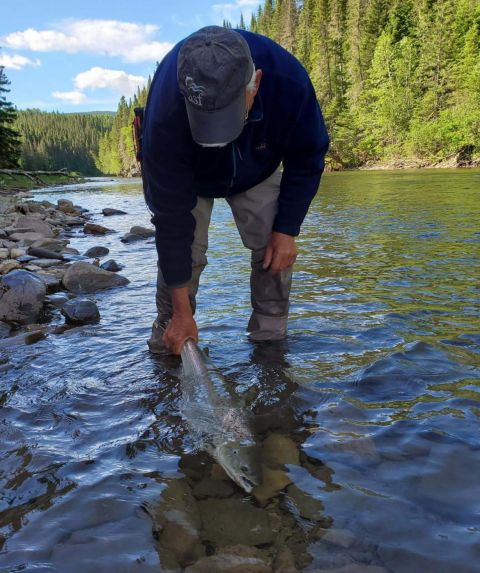
We have now reached the mid-way point of the regular recreational salmon season in NL, and by all accounts salmon returns to rivers throughout NL have been very encouraging to date. The latest DFO fishway counts, up to July 10th, along with reports from many anglers throughout the province, clearly indicate strong returns throughout the province. See the latest DFO fishway counts here: Atlantic salmon Fishway Counts.
Water levels on most rivers, with the exception of a few areas still remain in good shape. Meanwhile, warm air temperatures during the day have been causing water temperatures to warm throughout the day. However, cool nights are helping to decrease and moderate water temperatures. Thus, angling conditions have been pretty good for the past week, and reports indicate continued success throughout the province.
Regional Breakdown
Labrador
Chris Verbiski, owner of Atlantic Rivers Outfitting Company, Lewis River Lodge and Hunt River Lodge reports that returns appear to be in lockstep with last season and maybe even ahead. Most notable are the condition of both grilse and salmon, with the majority presenting with larger than usual bellies / fat reserves. The Hunt run is just beginning with ideal water levels. Early arrivals are exhibiting similar form as the southern returns with increased body weight.
Long time guide on the Forteau River, Lester Butt reports that there was a good sign of fish on the Forteau last week and fishing was pretty good. The water is a still a little high and remains cold due mainly to nighttime temperatures and dull weather during the day. Rob French, proprietor of The Bigland Adventure Lodge on the Pinware River, reports that the very high-water levels experienced on the Pinware River the week before last has now receded and the fishing on the river this past week was just fabulous. There are still many fish in the river (a good mix of large and small) and fishing conditions are currently great.
There have been reports of upwards of 10 commercial capelin seiners operating very close to the mouth of the Pinware River last week. A couple of salmon caught by anglers on the Pinware River were reported to have net marks on them. It is our understanding that concerned residents from the area videotaped the seiners operating near the mouth of the river, and even captured one seiner that went aground. This issue has been brought to DFO’s attention by ASF, and others in the past. We will continue to monitor and follow up with DFO.
Dwight Lethbridge, proprietor of Pratt Falls Lodge on the Eagle River, notes in his weekly ‘Eagle River Report’ that while heavy rain the week before last caused the Eagle River to rise, it was still fishable and the water temperature was cold. As a result the fishing was excellent and about 25-30% of the fish being angled were large. Dwight attributed this to the closure of the Greenland Commercial Fishery during the past few years.
Heather Crosby, Hawke River Lodge and Flowers River Lodge, reports that the fishing picked up on the Hawke River last week following a rise in water levels and cooler water temperatures. She also reports that their first guest for the season on the Flowers River arrived on July 16th, and upon doing so they immediately started enjoying good fishing. Flowers River is known for having a large proportion of large fish particularly during the early part of the season.
Southwestern Newfoundland
While water levels on most Bay St. George Rivers last week remained in fair condition and there was still a fairly good sign of fish in these rivers, warm water temperatures resulted in pretty slow fishing. However, reports indicate a few fish were still being hooked on these rivers, particularly during early morning fishing.
Western Newfoundland
High water levels on the lower Humber have started to recede and as a result fish are now starting to hold on this section of the river. As a result, angling activity has increased substantially, with most anglers reporting seeing a good sign of fish (both large and small). Angler, Donald Golden Eagle, landed a grilse late last week and angler Mike Murray landed two nice grilse in the last few days.
Angler, Ron Vincent, fished at ‘Big Falls’ on the Upper Humber on July 15th and reports that the water is still a bit high at this location, and the water is getting warm. This, of course, makes for slow fishing however, he managed to land a nice grilse.
Central Newfoundland
Reports indicate that there was a good sign of fish on the Exploits River last week and anglers are still enjoying some success. However, things slowed a little mainly because of a rise in water temperature.
Veteran angler, Dave Vardy, reports that he fished the lower section of the Gander River from July 18th-20th, and while water levels were low for this time of year, he reports seeing large numbers of fish moving through the river. In fact, he reports it was the most fish he has seen on the river for a long time. In addition to the many rises that he experienced, he managed to hook a few large grilse each day, thus making for a great fishing trip. Other anglers also reported good fishing on the lower Gander last week. Meanwhile, Tolson Parson, who is also a veteran angler, reports he fished the Gander River on July 18th up-river near Glennwood, and while he also saw a few fish moving in that area, the fishing was slow at that location.
On Middle Brook and Terra Nova Rivers, water levels are very low and temperatures are on the warn side. While fish counts have been good on these rivers to date, angling success has slowed because of the poor fishing conditions.
Avalon Peninsula
Many rivers on the Northeast coast of the Island and on the Avalon Peninsula are being closed by DFO due to low water conditions and warm water temperatures. See DFO Notice to Anglers for full details.
In the News
A new nature reserve in Western NL includes a donation from two brothers in memory of their father. The 79-hectare nature reserve borders Barachois Brook and Barachois Pond. See story at: CBC News | Brothers honour late father with land donation.

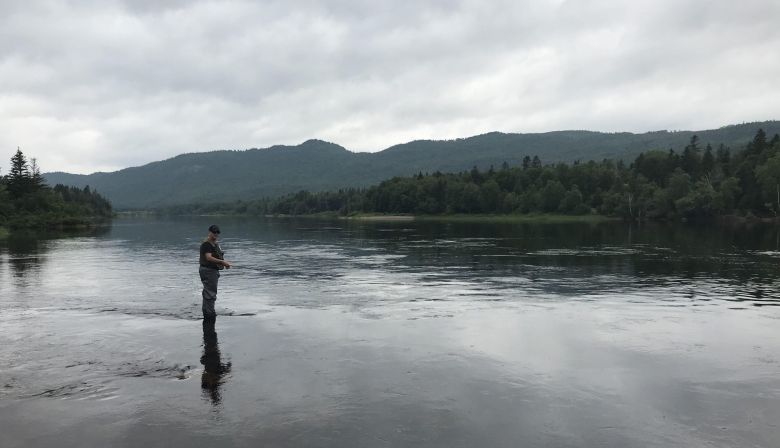
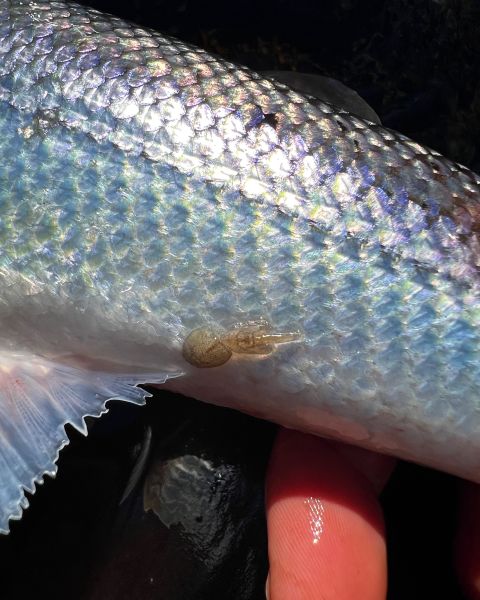
The fishing has remained pretty steady in Margaree, although a heat wave is moving in and the water is starting to get too warm, at times, for salmon fishing. I’ve gotten readings as high as the 20.0-21.7C range some afternoons. The water levels are still alright thanks to the wet June and early July, but it is getting low and we’ll need rain soon.
On the bright side, we’ve enjoyed a fantastic season here so far with good water and plenty of fish. It would appear to be a strong year for returns, even as the summer run tapers off we are still seeing some fresh fish with sea lice, as well as fish showing throughout the river.

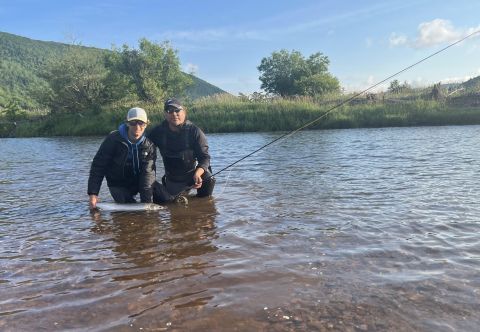
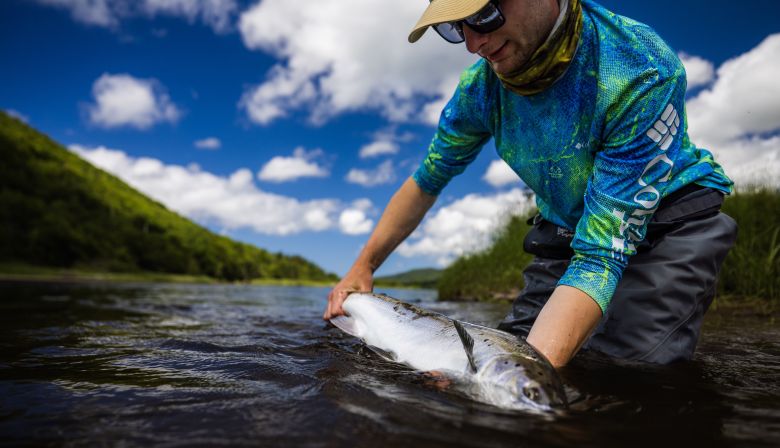
Fly fishing guide, Jimmie Pedersen took a family of four out fishing recently. When they arrived at the Forks Pool, the bench was full. Forks fished all morning and the gentlemen on the bench commented that no one had been down to the Dollar Pool yet. Jimmie and his clients marched down to the Dollar and saw a few fish roll. Jimmie spotted a silvery fish in amongst the others. He told one of his client’s sons, Oscar, that it is likely a fresh, taking fish with sea lice. Oscar was fishing a dry fly and as Jimmie watched him cast, he instructed Oscar when pulling the fly off the water to “cast again and pull it off the water slowly”. Once he did this on his next cast, the bright fish came like a bat out of hell for the fly.
Oscar set the hook beautifully. The fish put on a full acrobatic show, somersaulting around the pool, complete with jump, flips and rolls. Behaving just as a proper Margaree summer fish should. Jimmie tailed the fish for young Oscar, and his father, Steve Sasso snapped a few quick photos. The fish was revived and released to swim back to her lie.
The gentlemen at the Forks Pool watched with pleasure as all this unfolded. They didn’t move down to the Dollar Pool but rather left the family and Jimmie to continue their fishing adventure. A show of true sportsmanship from the bench and other anglers on the river. Over and above etiquette.
Steve Sasso also shared these comments surrounding his family’s time riverside with Jimmie:
Not only does he know how to fish for salmon, he has a deep understanding of the environment and great respect for these incredible fish. As a father and the only truly passionate fisherman in my family, I truly enjoyed watching Jimmie impart his passion for salmon fishing to my family.
Follow Nature Photographer and Fly Fishing Guide, Jimmie Pedersen on Instagram: @speysimplicity
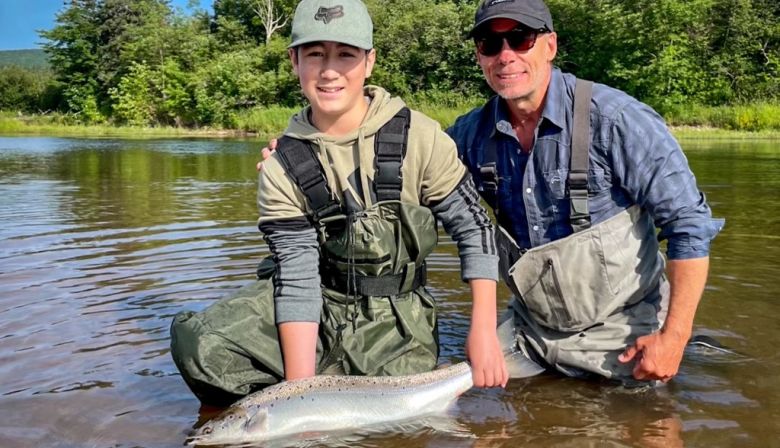
Upcoming Events
Join the Sackville Rivers Association (SRA) on Friday, September 16th, 2002 for their Annual Dinner & Silent Auction.
Check out SRA’s website where you can become a member for FREE. And follow them on Instagram @sackvillerivers today!

At the Morgan Falls Fishway on the Lahave River, 74 large salmon and 34 grilse passed as of Monday, June 20th.
DFO notes that their website has not been updated but they hope to have it back online soon.
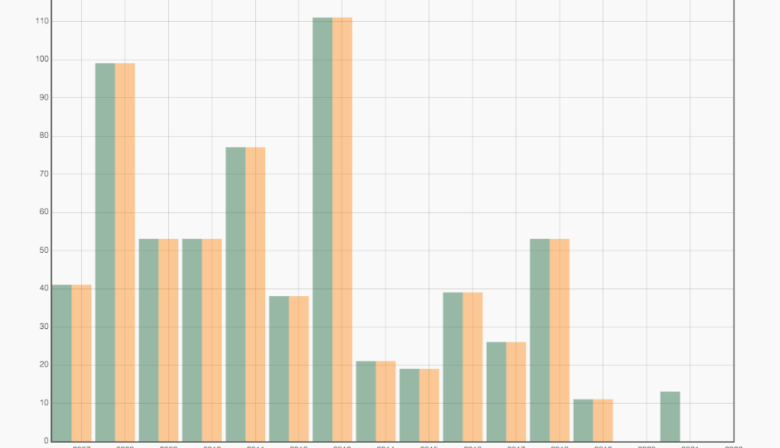
The Alta River in Artic Norway, known for its huge salmon, is experiencing a very large run and its best season in 30 years. During six days between July 6-12th, a group of six international rod owners including ASF directors Mollie Fitzgerald, Ed Shugrue, caught 88 salmon (not including grilse) on the Alta. Three fish were over 40 pounds, including the beautiful salmon pictured with Ed Shugrue in last week’s RiverNotes.
My son Mark Buckley hooked a massive salmon in the Alta’s fabled Upper Sierra pool on July 10th. He had it on for two hours and ten minutes before the fly finally pulled out. The fish took us a mile and a half downriver. It stayed down, was never under control and never really tired. I’ll probably never have another experience like that in my lifetime, but I hope that my son does.
The Alta, perhaps the most famous “big fish” river, has produced some enormous salmon even in modern times, including a 66 pounder caught in the Upper Sierra in 2014 and an 82 pounder caught in an estuarine net in 2008. The salmon that took Mark’s fly was one of those monsters, and it is comforting to know that they still exist in the Alta.
